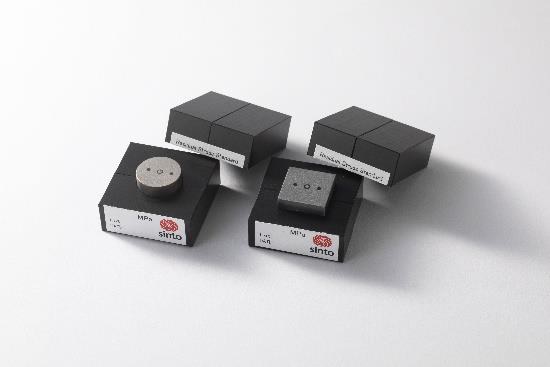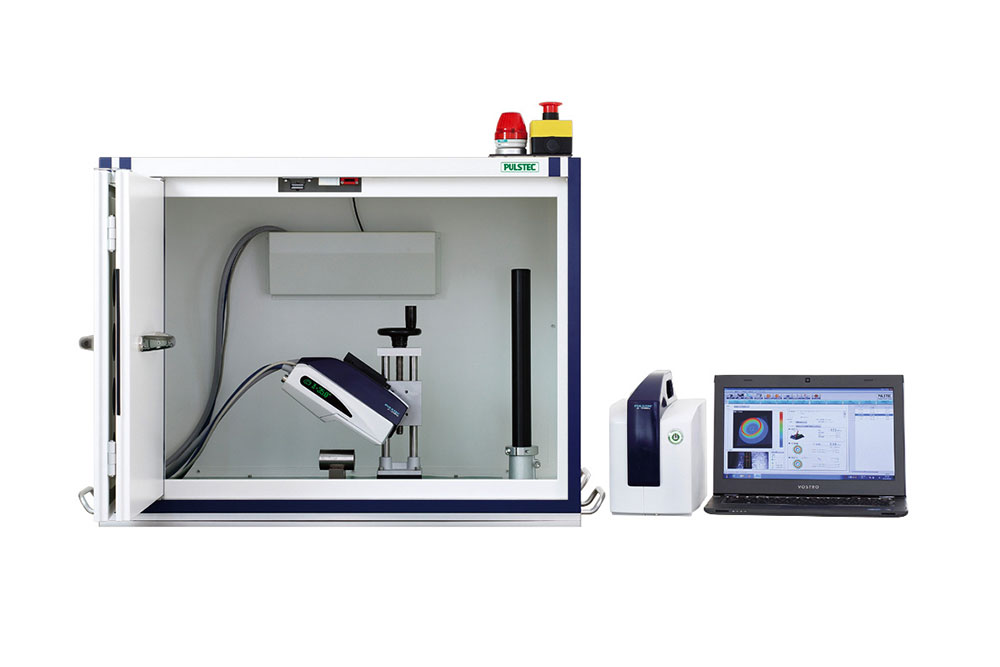
Pulstec is proud to be the brand behind the μ-X360s—the world’s smallest and lightest X-ray analyzer. Diverging from the conventional sin2ψ method, our analyzer uses the cosine alpha technique, a significant advancement in X-ray diffraction technology. The μ-X360s is portable, user-friendly, and can be used to measure residual stress and retained austenite both off-site and in the field.
In this technical document, we’ll describe how you can use our analyzer to perform easy on-site/field measurements.
Table of Contents
1. Prepare Your Test Sample

First, prepare your test sample for measurements. When preparing samples, ensure the following:
- Material Suitability: Our analyzer can measure polycrystalline material, including ferritic and austenitic steel, titanium, aluminum, nickel, and ceramics such as SiC and AI203.
- Proper Surface Preparation: Ensure the measurement spots on the sample are free from surface coatings, tapes, paints, or rust.
- Compatibility Between Sample Material & X-ray Tube: Pick the right X-ray tube for the material being tested. For example, Chromium tubes are recommended for ferritic steel and aluminum test materials, while Vanadium is recommended for titanium and ceramics. Please view this resource for more guidance.
- Sample Size Is Correct: The maximum sample size is 12 inches with our standard size shield box. Without the shield box, there are no size or weight limitations. The minimum size is equivalent to the X-ray spot size. Pulstec offers 0.3, 0.5, 1.0, and 2.0 mm collimators, and a collimator exchange for easy swapping.
- Access to High Measurement Spots: If your test material is located in a high spot, ensure it’s prepared on a stable fixture and accessible via lift, steps, or ladder.
- Fair Weather: Never perform on-site measurements in severe weather conditions, like rain, snow, heavy winds, or high humidity, to prevent equipment damage.
2. Prepare the Testing Environment
Next, prepare the testing environment by:
- Setting Up the Equipment: Use the tripod and flexible arm to mount the X-ray analyzer. Mount the sensor unit on the flexible arm, then attach the arm to the tripod. If necessary, secure the tripod with rope for additional stability. We also have a cart that can support the X-ray analyzer should larger components need to be tested.
- Creating a Radiation Safety Area: Establish a 2-meter radius from the equipment and mark it with red tape. This is your radiation safety area. We also recommend using a survey meter to check radiation levels.
- Employing a Radiation Safety Officer (RSO): An RSO is required to approve on-site testing after the safety zone has been established.
- Ensuring Operator Protection: To safeguard against radiation exposure, place PVC or steel shielding boards between the equipment and the operator.
3. Check the Machine’s Condition

Before conducting measurements, checking the machine’s condition is crucial to ensure accurate and reliable results. Look for any signs of damage or wear, ensure all connections are secure, and verify that the software functions correctly.
Additionally, calibration is a critical step in the process. It aligns the machine with known standards, further ensuring accuracy and reliability. If calibration is needed, perform one. When you purchase the μ-X360s, we will provide a calibration standard. Please read this technical document for more information on our calibration standard and reference standards.
4. Prepare the Machine for Measurements
After ensuring the machine is calibrated and in good condition, you’re ready to prepare the machine for measurements by:
- Aligning the sensor unit precisely over the test spot on the sample.
- Opening the measurement wizard in the software, which will guide you through the setup process for your measurement.
- Adjusting the angle at which the X-rays hit the sample to optimize the measurement.
- Using the CCD camera image and LED marker to adjust the distance between the sample and sensor and correctly align the measurement position.
5. Start Measurements

Before you start measurements, ensure the operator is either two meters away from the equipment in the designated safety zone or behind the shielding board.
When you can confirm operator safety, you can start measurements. Use the measurement wizard to start measurements—when measurements begin, the warning lamp on the equipment will flash red.
X-ray irradiation will last for approximately 15 seconds for materials like ferritic steel. Once the red light turns off, it’s safe for the operator to step away from the shielding board or out of the safety zone.
After 60 seconds, the measurement results will be displayed in the software.
6. Validate the Results
Once you see the displayed results in the software, you’ll need to validate them by ensuring the Debye-Scherrer ring is uniform, and the measurement error (standard deviation) is acceptably small.
The results will have sections for residual stress, FWHM, and retained austenite. Note that the option to measure retained austenite must be requested when you purchase the μ-X360s. The Debye-Scherrer ring can be viewed in full detail in a 2D or 3D view, and you can view and analyze peak profiles by selecting sections of the ring.
To measure residual stress, you will need to calculate the strain by comparing the change in spacing between crystal planes to the known unstrained spacing and then apply Hooke’s Law.
Recommended Optional Items for On-Site Measurements
Pulstec offers optional items for the μ-X360s. If you are planning to perform field measurements, we recommend purchasing our:
- Watertight and crush-proof case, which holds the main unit, flexible arm, safety shielding, and angle gauge
- Angle gauge
- Battery to operate the analyzer without electricity
- Tripod
- Flexible arm
- Shielding board
- Laptop (with XRD analyzer software)
While Pulstec does not offer these items, we recommend purchasing a radiation survey meter, anchor, and rope to ensure safety when on-site measurements are performed.
Request a Demo Today
Do you have questions about how to use the μ-X360s? Please contact us today to speak with our product specialist or to schedule a free demo or sample testing.

